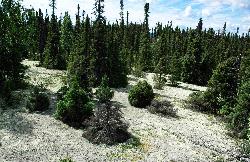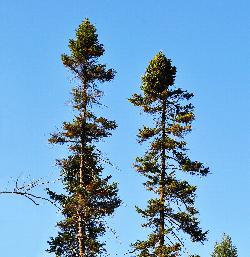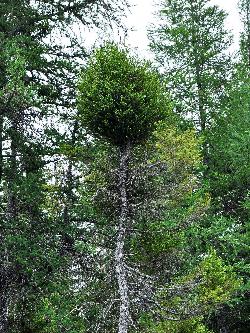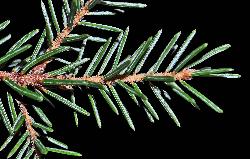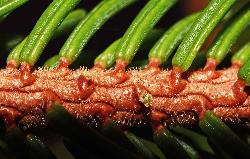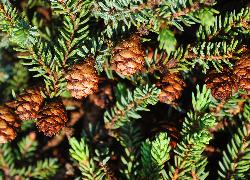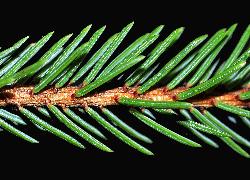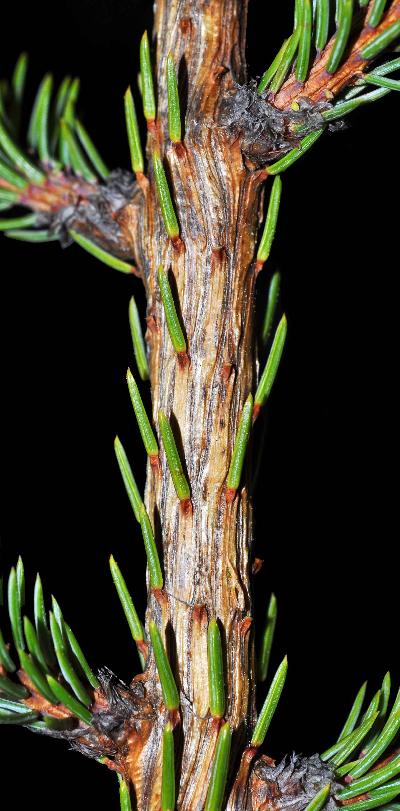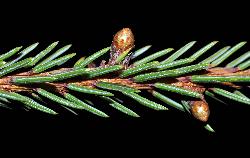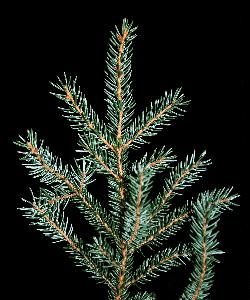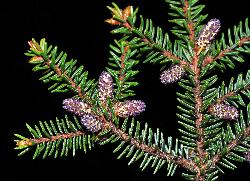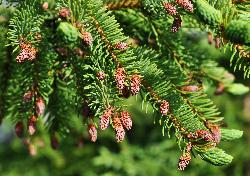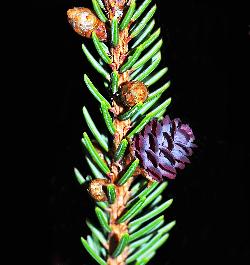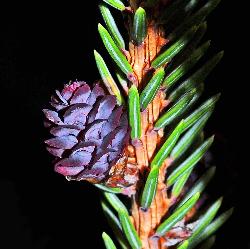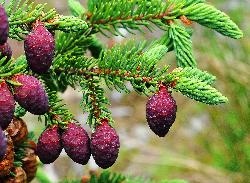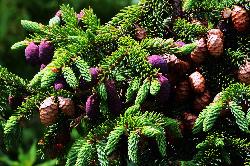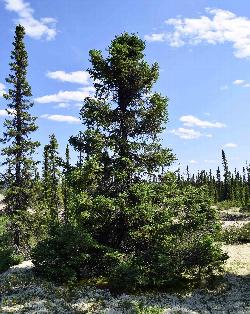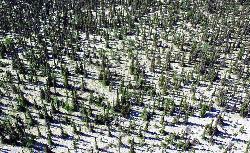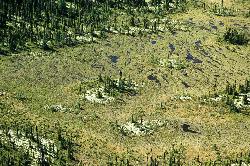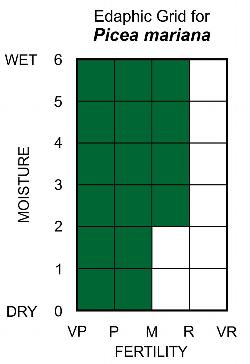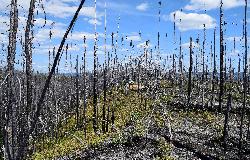Fr: épinette noire, épicéa noir, épinette à bière, épinette des marais
IA: sheshekatiku, ushkatiku, minaiku-uskhuetui (cone)
Pinaceae - Pine Family
Note: Numbers given in square brackets in the text refer to the images presented above; image numbers are displayed to the lower left of each image.
General: A small to medium-sized evergreen tree, reaching 20 m tall, with a 30 cm d.b.h. trunk, and living up to 200 years (Farrar 1995). Black spruce trees often have a narrow columnar shape with a dense club-shaped top formed by the accumulation of several years of cone crops in the short crown branches [1–3]. Black spruce is a shallow-rooted species, very susceptible to windthrow, and is less shade-tolerant than balsam fir. Although it often grows on nutrient-poor peatland sites, black spruce is intolerant of flooding. Black spruce is also a pioneer species on recently burned sites, where the intense heat of the fire causes the semi-serotinous cones to gradually release their seeds, which germinate most successfully on exposed mineral soil.
Commercially, black spruce is considered to be the most important pulpwood species in Canada (Viereck and Johnston 1990), and is the species used in Newfoundland to produce spruce beer, an alcoholic beverage historically brewed to counteract scurvy during long ocean crossings.
Within the forest, black spruce is important to wildlife as a valuable source of cover and abundant food (seeds, buds) for moose, and small mammals and birds, such as red squirrel, spruce grouse, pine grosbeak, and crossbills (Viereck and Johnston 1990).
In Newfoundland, black spruce is the preferred host of eastern dwarf mistletoe (Arceuthobium pusillum Peck), a dwarf parasitic plant that causes witches' brooms – an abnormally dense growth of short branches [4].
Key Features:
- Black spruce trees have a narrow profile with a characteristic club-shaped crown, formed by the presence of years of unopened cones that persist in the upper crown branches [2].
- Twigs are densely pubescent with short brown glandular and non-glandular hairs [5].
- Needles narrow abruptly to small persistent peg-like bases (sterigmata), which remain attached to the twig after the needles fall [6]; sterigmata are found on the twigs of all spruce species.
- Seed cones are semi-serotinous, ovoid, 2–3 cm long [7], and are retained in the crown of the tree for many years, shedding most of their seed after exposure to fire or extreme heat.
Stems/twigs: Young twigs are light brown and densely pubescent with non-glandular hairs. Newly emerging twigs bear short whitish hairs [8] that soon mature to brown [5–6]; older twigs are darker reddish-brown and nearly glabrous [9–10]. The short, conical to ovate buds are 3–5 mm long, with reddish-brown to yellowish-brown scales; outer bud scales are few, narrow, and sharply pointed, while inner bud scales are ovate and blunt [11]. The bark is grayish-brown and scaly.
Needles: Evergreen, simple, stalked, and spirally arranged around the stem [11–12]. Needles are slender, stiff, straight to slightly curved, 6–15 mm long, dark green to bluish-green, glabrous, and often somewhat glaucous. The 4-angled needles also have a distinct white line along each side, formed by parallel rows of small white dot-like stomates [9, 11]. The tips of the needles are stiff and blunt (obtuse) to pointed (acute). Spruce needles narrow abruptly at the base to woody peg-like attachments (sterigmata), which are persistent and decurrent along the stem [6, 9]. The sterigmata of black spruce are slightly darker than the decurrent portion of the needle bases.
Reproductive structures/cones: Unisexual, with separate male and female cones borne on the same tree (plants monoecious). Both male (staminate) and female (pistillate) cones are borne on year-old branches. Male cones are oblong, 1.2–2 cm long, dark reddish-purple when young, but become brown and deciduous after pollen is shed [13–15]; pollination is by wind (anemophily). Immature female cones (conelets) are ovoid, 1.5–2.5 cm long, dark purple when young [16–17], becoming reddish purple, then brown, 2–3 cm long, blunt at the tip, and pendant at maturity [18–21]. Mature seed cones have obovate cone scales with rounded, erose, outer margins. After seeds are shed, the cones are nearly spherical in shape [7]. Black spruce cones mature in one season, but may remain on the tree for 25 years or more, releasing their seed gradually in the absence of fire; the cones are semi-serotinous and, following exposure to extreme heat or fire, most of the seed crop is released. Black spruce seeds are about 2 mm long, light in weight, and have an obovate wing about 2–4 mm long; seeds disperse primarily by wind (anemochory), but red squirrels and other animals may be unintentionally responsible for dispersing wind-transported seed not consumed during their harvesting activities.
Red squirrels are often reported to be "responsible for the characteristic 'bunchy' appearance of black spruce crowns" by pruning cone-bearing shoots and eating young vegetative and cone buds (Viereck and Johnston 1990; Heinselman 1957). LeBarron (1948, pg. 21) wrote:
When squirrels gather black spruce cones, they clip off entire twigs with the cones attached. Sometimes this results in a considerable amount of pruning near the tops of the trees where the cones are borne. Examinations of the upper portions of numerous trees has shown that the characteristic 'bunchy' appearance of black spruce tops is caused by such pruning.
However, the club-shaped crowns of black spruce develop naturally as successive years of cone crops are retained in the crown. Lutz (1956, 1958) clarified the role that red squirrels play by observing that "red squirrels prune shoots right to the leader, forming gaps between the cones and lower branches," which he theorized helped prevent cone crops from being destroyed by fire.
Ecology & Habitat: Black spruce occurs throughout Newfoundland and Labrador, from sea level to elevational and latitudinal treelines. In the absence of fire disturbance, black spruce forms stable forests on extremely dry and wet sites, where it exhibits slow growth and a scrubby form. Black spruce displays good growth and form on dry to moist upland sites, where it replaces balsam fir as the dominant tree after wildfire. Black spruce is also the dominant tree in the subarctic lichen woodlands of northern Labrador. On very exposed sites and near treeline, black spruce and other conifers are dwarfed by wind- and frost-pruning, producing a stunted growth form known as krummholz, locally called tuckamoor. Black spruce is a fire-adapted species that releases seeds from semi-serotinous cones after fire. Seed germination is most successful on exposed mineral soils and, where fires do not scarify the humus layer, establishment may be poor, leading to the formation of open black spruce-shrub woodlands that have long-term stability.
Black spruce also reproduces asexually through layering, which occurs when low lying branches, in contact with wet soil, root and send up vertical shoots that develop into independent trees (new ramets) [22]. Layering occurs most commonly in open habitats, such as lichen woodlands [1, 23–24], on the margins of peatlands [3, 25–26], and in coastal and high elevation sites that have very high humidity.
Edaphic Grid: See image [27]: the Edaphic Grid for Picea mariana.
Forest Types: On upland sites, Black spruce most commonly occurs In the Piceetum marianae (Black Spruce-Moss Association), which is characterized by an understorey of sporadic ericaceous shrubs and a continuous feathermoss carpet dominated by Pleurozium schreberi and Hylocomium splendens. This association occurs over a wide spectrum of soil conditions from dry-nutrient poor shallow soils to nutrient-rich seepage slopes.
On lowland sites, it occurs most commonly in the following types:
- Carici-Piceetum (Carex-Black Spruce Fen Association)
- Osmundo-Piceetum (Osmunda-Black Spruce Fen Association)
- Sphagno-Piceetum (Sphagnum-Black Spruce Bog Association)
Black spruce is also the dominant species in open woodland conditions including the Kalmio-Piceetum nemopanthetosum (Nemopanthus-Kalmia-Black Spruce Forest Subassociation) and Kalmio-Piceetum-sphagnetosum (Kalmia-Sphagnum-Black Spruce Forest Subassociation), which are the transitional scrub forest on bog margins. On extremely dry sandy soils, black spruce is a stable cover type in the Kalmieto-Piceetum cladonietosum (Cladonia-Kalmia-Black Spruce Forest Subassociation), whereas in open woodlands of fire origin, it dominates the Kalmieto-Piceetum typicum (Kalmia-Black Spruce Forest Subassociation). While Kalmia angustifolia can be abundant in the early seral phase following fire in central Labrador lichen woodlands [28–30], it does not persist in later successional stages, as is the case on the Island of Newfoundland. This may be due to the fact that it is near its climatic limit in central Labrador, with extremely dry sandy soils and less precipitation. In northern Labrador, this type is replaced by lichen woodlands with Betula glandulosa that are also of fire origin, but appear to have long-term stability. On limestone soils, it has only been described as a dominant in the Oryzopsis-Black Spruce Community (Damman 1967) in western Newfoundland.
Succession: Under the extremely humid climate of coastal Newfoundland and Labrador, black spruce-dominated forests occur as a stable azonal forest type on extremely dry soils (sands, gravels, and shallow soils) or extremely wet soils (transitional to open peatlands). On most dry to moist upland conditions, it is replaced by balsam fir as the stable zonal type. However, within interior regions experiencing less precipitation and fog, wildfires are more frequent, and black spruce, because of it semi-serotinous cones, often replaces balsam fir on the landscape, either in pure stands or in a mixture of balsam fir and black spruce. Left undisturbed, these forests will revert back to balsam fir dominance over several generations. The open black spruce woodland condition usually arises from poor seedling establishment after fire. This may be due to poor viable seed supply at the northern treeline or poor seedbed, when fire is not intense enough to remove the humus layer and expose mineral soil. In either case, studies have shown that, once formed, these woodlands have considerable long-term stability.
Distribution: Black spruce is one of the most widely distributed species, occurring from eastern Newfoundland to Alaska. Northward, it extends into the subarctic treeline as a scrubby flagged tree or even in prostrate mats. It occurs south to the Lake States, usually in wetland habitats.
Similar Species: White spruce (Picea glauca (Moench) Voss), is a much broader and usually taller tree than black spruce; it can be differentiated from black spruce by its glabrous stems, longer needles, 1.5–2.2 cm long, and much longer, cylindrical cones, 3–6 cm long, which are deciduous after seeds have shed. Although uncommon in Newfoundland, red spruce (Picea rubens Sarg.) does occur in a small area north of Bay D'Espoir on the south coast of Newfoundland. Mature red spruce twigs are slightly pubescent, but the hairs are pale and non-glandular, in contrast to the usually dense cover of brown glandular and non-glandular hairs on black spruce twigs. The narrowly ovoid cones of red spruce are 3–5 cm long, slightly larger and longer than those of black spruce, which are 2–3 cm long.


